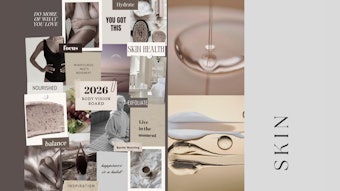
The professional skin care industry saw growth and innovation in 2022. With spa professionals once again filling up their books, we can expect the spa industry to be better than ever in 2023. However, with financial predictions somewhat concerning for the upcoming year, it is important that we thoroughly do our research to answer our clients’ needs and wants as we move into the future. Discussed here are the trends in skin care that I believe will make waves in 2023. Adopt a few, or perhaps one, of these trends in 2023, and be recognized by your clientele for your forward thought.
1. Skin Cycling
During the height of the pandemic, as clients and professionals alike were stuck at home navigating their personal care and beauty routines solo, dermatologist Whitney Bowe, M.D., had an epiphany. Upon switching up her workout routines to promote different effects and recover, she realized that the same thought process could be applied to skin care. She coined “skin cycling” as a four day method to rejuvenate the skin but also allow recovery. It is a way to simplify a client’s routine but keep it effective. The first night is exfoliation, preferably with a chemical exfoliant, followed by a retinol on night two. The third and fourth nights are about healing and moisturization, and the process begins all over again on night five. If you have clients that want to see better results from their skin care routine but are overwhelmed by complicated regimens, this may be an easier way to help them (and move some retail sales in the process).
Related: Skin Cycling: The Buzz Behind TikTok's Skin Care Trend
2. Mamey Sapote
There are many familiar faces when it comes to important ingredients for 2023, according to a report by Trendalytics.1 Peptides, algae, L-glutamine, kojic acid and retinol are all marked to grow in the coming year. Winter cherry, is also set to grow, but it has largely been in recent trend reports as its sexier name ashwagandha. One surprising ingredient predicted to emerge in the upcoming year is mamey sapote. Those with Latin American roots may be familiar with the health and skin benefits of this fruit, but it has been making waves recently in global skin care formulations. Although it carries a host of health benefits with it, its skin care benefits are largely due to its high concentration of vitamins and minerals. It serves as an antioxidant and moisturizer in skin care, and carries many of its benefits over to hair care as well. Expect to see it pop up in new formulations and perhaps treatments in 2023.
3. Beauty Minimalism
Consumers felt a squeeze on their finances in 2022, with inflation increasing the costs of nearly everything with seemingly no relief in sight. A number of financial experts predict a recession in 2023, possibly lasting the entire year. This past year, we saw the introduction of the term “skinimalism,” or skin minimalism, and I believe that this concept will continue in 2023, in some shape or form, as purse strings tighten even tighter. This trend is about minimizing the amount of products in a client’s regimen to focus on the ones that deliver true skin health and results. As you have clients asking about simple skin routines, be able to recommend a handful of products that will bring them efficacy. An important note is that this is not about cheap products, but rather about frugality. Clients will be focused on getting the most bang for their buck. Be ready and prepared for this now.
4. Out of the Box Acids
Gone are the days where the skin care professional had a limited arsenal of acids to rejuvenate the skin. Matter of fact, many alternative acids are emerging that offer comparable results to tried and acids with additional skin benefits. Think beyond glycolic, salicylic, hyaluronic, lactic, mandelic and malic acid, and consider acids such as polyglutamic, fermented jasmonic, lactobionic and tranexamic acid.
Let’s discuss a few of these here. Polyglutamic acid is said to perform better than the skin care hydrator hyaluronic acid. It is reported to hold four times more water than hyaluronic acid and bind better to the skin. You may have been hearing more about polyhydroxy acids recently, and lactobionic acid is one such acid, offering exfoliating benefits to sensitive skin, while serving as a humectant and antioxidant for additional benefits to sensitive and dry skin.
Related: Jar Deconstructed: Polyhydroxy Acids
5. PRP Boosted
We all know the anti-aging benefits of PRP, but what if I told you that with a small modification, you can continue these anti-aging results into the future? Enter platelet-rich fibrin (PRF). While PRP encourages new stem cell growth in the skin, PRF releases more growth factors over time. This is because fibrin is what platelets bind to in the blood to release growth factors to heal the body. More fibrin = more growth factors. Both PRP and PRF are taken from a patient’s own blood. However, PRF is spun at a lower speed, and no-anti-coagulant is used. Without this anti-coagulant, PRF is thicker, making it absorb in the body slower but also allowing it to be more natural than its PRP alternative.
Find the rest of the top 10 skin care trends for 2023 in our December Digital Magazine...












